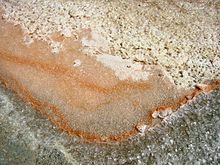Dunaliella salina
| Dunaliella salina | |
|---|---|
 |
|
| Orange-colored Dunaliella salina within sea salt | |
| Scientific classification | |
| Kingdom: | Plantae |
| Division: | Chlorophyta |
| Class: | Chlorophyceae |
| Order: | Chlamydomonadales |
| Family: | Dunaliellaceae |
| Genus: | Dunaliella |
| Species: | D. salina |
| Binomial name | |
|
Dunaliella salina |
|
Dunaliella salina is a type of halophile green micro-algae especially found in sea salt fields. Known for its antioxidant activity because of its ability to create large amount of carotenoids, it is used in cosmetics and dietary supplements. Few organisms can survive like D. salina does in such highly saline conditions as salt evaporation ponds. To survive, these organisms have high concentrations of β-carotene to protect against the intense light, and high concentrations of glycerol to provide protection against osmotic pressure. This offers an opportunity for commercial biological production of these substances.
Dunaliella salina was named by E.C. Teodoresco of Bucharest, Romania after its original discoverer, Michel Felix Dunal, who first scientifically reported sighting the organism in saltern evaporation ponds in Montpellier, France in 1838. He initially named the organism Haematococcus salinus and Protococcus. The organism was fully described as a new, separate genus simultaneously by Teodoresco and Clara Hamburger of Heidelberg, Germany in 1905. Teodoresco was the first to publish his work, so he is generally given credit for this categorization.
Species in the Dunaliella genus are morphogically similar to Chlamydomonas reinhardtii with the main exception being that Dunaliella lack both a cell wall and a contractile vacuole. Dunaliella has two flagella of equal length and has a single cup-like chloroplast that often contains a central pyrenoid. The chloroplast can hold large amounts of β-carotene, which makes it appear orange-red. The β-carotene appears to protect the organism from long-term UV radiation that D. salina is exposed to in its typical environments. D. salina comes in various shapes and symmetries depending on the conditions in its current environment.
...
Wikipedia
